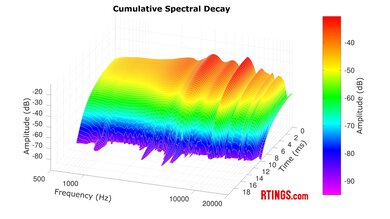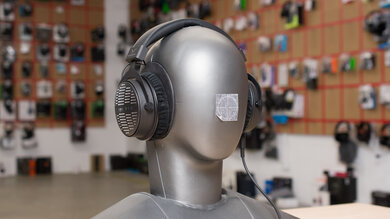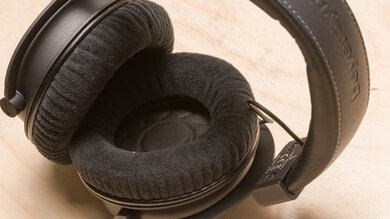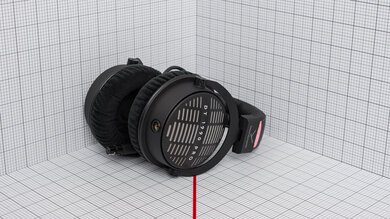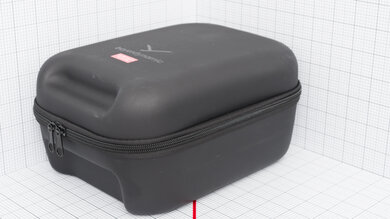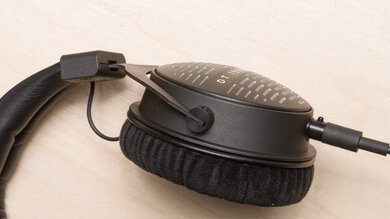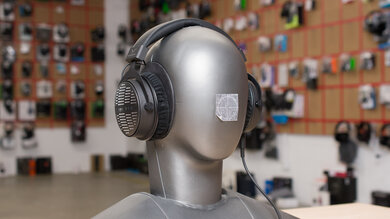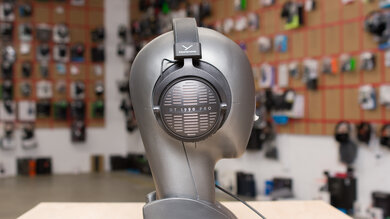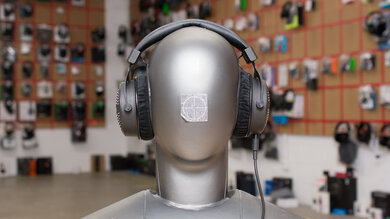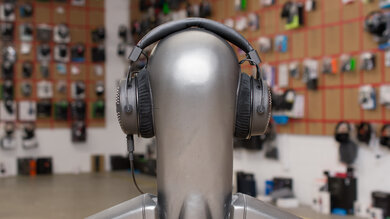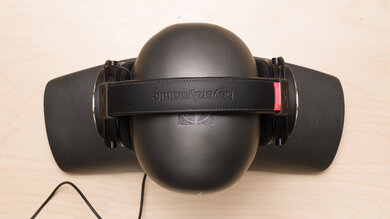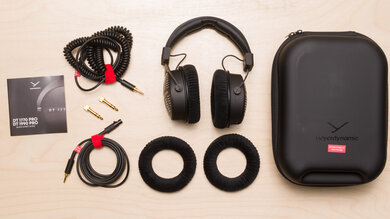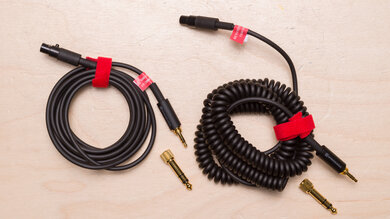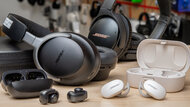The Beyerdynamic DT 1990 PRO MKII are premium, studio, over-ear headphones. They're well suited for both producing and mastering and include two sets of ear pads expressly designed for those usages. Additionally, these headphones are made in Germany and have quality materials with solid construction. Their 30-ohm impedance also makes them usable on most devices without an amp.
Our Verdict
The Beyerdynamic DT 1990 PRO MKII aren't designed for sports and fitness. While they have a fairly high clamping force to keep them stable, they're quite heavy and bulky. Also, you can only use them wired, making the headphones impractical and potentially hazardous for physical activity.
-
Comfortable fit.
-
Open design lets in background noise.
-
Bulky design.
The Beyerdynamic DT 1990 PRO MKII are inadequate for commuting and travel. They don't have an active noise cancellation system and are open-back headphones, meaning they don't passively or actively block out ambient noise. Whether riding a bus or flying sky-high, you'll hear the rumble of engines and the din of ambient chatter through these cans. That said, they come with a case that makes transporting them manageable.
-
Comfortable fit.
-
No microphone.
-
Open design lets in background noise.
-
Bulky design.
The Beyerdynamic DT 1990 PRO MKII are poor for office use. They lack a microphone, so you'll have to use your connected device's integrated microphone (if it has one) for Zoom or Teams meetings. Meanwhile, their open design isn't meant to mitigate noise or prevent leakage; you'll hear everything from ambient conversations to clacking keyboards in a busy office. Additionally, any neighboring colleagues will hear whatever you're listening to, especially if you have the volume turned up.
-
Comfortable fit.
-
Minimal variation of sound signature between wears.
-
No microphone.
-
Open design lets in background noise.
-
Bulky design.
The Beyerdynamic DT 1990 PRO MKII are wired-only headphones and are unsuitable for wireless gaming.
The Beyerdynamic DT 1990 PRO MKII are okay for wired gaming. You can use them as an audio output device with PCs, PlayStation, and Xbox, but they don't have a microphone; you'll have to find an external mic or aftermarket cable with an in-line mic if you'd like to communicate with friends or teammates through voice chat. That said, these comfortable headphones have great frequency response consistency; positional cues will sound the same even if you have to adjust them or have long hair or wear glasses—you'll be able to consistently identify footsteps from any given direction.
-
Virtually no latency.
-
Comfortable fit.
-
Minimal variation of sound signature between wears.
-
No microphone.
-
Open design lets in background noise.
-
Bulky design.
The Beyerdynamic DT 1990 PRO MKII have great audio reproduction accuracy. They don't deviate much from their balanced sound, and they have well-aligned left and right drivers, ensuring objects are accurately placed in the stereo field. While they're missing a bit of punch and thump in the low- and mid-bass, which is expected from open-back headphones, their mid-range closely follows our target curve, rendering natural and clear vocals and instruments. However, fluctuations in the treble can cause their sound to undulate from under- to over-articulated. Though they're open-backed headphones, they don't produce audio that interacts much with your outer ear, so their sound doesn't closely resemble that of two angled reference monitors in an acoustically treated room.
The Beyerdynamic DT 1990 PRO MKII aren't designed to block out noise, so you'll hear most of the sounds around you, from office chatter to engine rumble.
The Beyerdynamic DT 1990 PRO MKII don't have a microphone.
The Beyerdynamic DT 1990 PRO MKII have impressive frequency response consistency, so you can expect consistent sound with each wear.
- 5.9 Sports And Fitness
- 5.4 Travel
- 3.8 Office Work
- 4.7 Wireless Gaming (In Development)
- 6.8 Wired Gaming (In Development)
Performance Usages
- 8.1 Audio Reproduction Accuracy
- 2.9 Noise Isolation
- 0 Microphone (In Development)
- 8.1 Frequency Response Consistency
Changelog
-
Updated Jul 29, 2025:
We've updated the Sound Profile box with a link to a downloadable folder of EQ settings that will help you match these headphones' frequency response to different target curves available in our Graph Tool.
-
Updated May 21, 2025:
This review has been updated to Test Bench 2.0, which adds the following tests: Stereo Mismatch, Group Delay, Cumulative Spectral Decay, PRTF, Harmonic Distortion, and Electrical Aspects. We've added new performance usages and updated the text throughout the Sound tests and side-by-sides.
- Updated May 14, 2025: We've converted this review to Test Bench 2.0, which updates our sound tests and adds performance usages. You can read more about this in our changelog.
-
Updated Mar 26, 2025:
We referenced the Audio-Technica ATH-ADX3000 in the Passive Soundstage box.
- Updated Feb 26, 2025: Review published.
Check Price
Differences Between Sizes And Variants
These headphones only have a 'Black' variant, which has a gunmetal finish on both plastic and metal components. You can see two labels with the product's origin and manufacturer location.
If you encounter another variant of these headphones, please let us know in the comments, and we'll update our review.
Popular Headphones Comparisons
The Beyerdynamic DT 1990 PRO MKII are open-back headphones positioned as premium studio monitors by their manufacturer. Made in Germany with high-quality construction, these headphones succeed the original Beyerdynamic DT 1990 PRO and come in at a higher price than the Sennheiser HD 490 PRO, which share a similar position in the market—both include two pairs of earpads for mixing and producing usages. This price discrepancy shows itself in nice-to-haves like an included hard case and more liberal use of premium materials on the Beyerdynamic. Relative to the rest of their manufacturer's lineup, these are the step up from the more budget open-back Beyerdynamic DT 990 PRO. If you like the build and design of the DT 1990 PRO MKII but prefer the bass of something closed-back, the manufacturer sells a nearly identical closed-back pair of headphones positioned in the same category: the Beyerdynamic DT 1770 PRO.
If you're searching for critical listening or professional headphones, check out our articles for the best open-back headphones, the best audiophile headphones, and the best studio headphones.
The Beyerdynamic DT 990 PRO are the stepped-down version of the Beyerdynamic DT 1990 PRO MKII. They're both open-backed headphones and have a similar design. The MKII are built better and come with a hard carrying case and extra ear pads. In terms of sound signature, both headphones produce a well-balanced sound suitable for a variety of genres. The DT 990 PRO have a bit of extra high-bass and fewer fluctuations in the treble.
The original Beyerdynamic DT 1990 PRO are the predecessor to the Beyerdynamic DT 1990 PRO MKII. Both headphones are extremely similar with only minor differences in sound signature; in the treble, the original model have fewer but more pronounced deviations from our target curve across bands—vocals and instruments, in general, sound underarticulated and slightly piercing. In contrast, the MKII have more fluctuations across bands, leading to more alternation between too much or too little articulation and brightness. Unlike their predecessor, they also have a lower impedance and don't require an amp to drive them.
The Sennheiser HD 490 PRO and the Beyerdynamic DT 1990 PRO MKII are similarly positioned headphones. Both are open-backs designed for professional use, with two sets of ear pads for mixing and producing. While both have well-balanced sound signatures, the Sennheiser reproduce audio with slightly more punch and thump in their low and mid-bass and fewer fluctuations in their treble range. That said, the Beyerdynamic come with extras like a hard shell carrying case and an extra coiled cable.
The Beyerdynamic DT 1770 PRO are a closed-back sibling to the Beyerdynamic DT 1990 PRO MKII. Both headphones have a similar design and are equally comfortable. The DT 1770 PRO have a more prominent bass thanks to their closed design, while the MKII allow environmental interaction to help their soundstage sound more open and immersive.
The Audio-Technica ATH-ADX3000 and the Beyerdynamic DT 1990 PRO MKII are remarkably similar headphones. Both of these open-backed headphones combine a fantastically balanced mid-range with a slightly bright treble, but the Beyerdynamic are notably cheaper than the Audio-Technica. That said, the Audio-Technica have a more immersive, open soundstage and are lighter to wear.
Video

We've upgraded our Headphones Test Bench to 2.0! This update brings several key changes to our tests and usages, making it easier than ever to interpret our sound results based on your personal preferences. You'll also find a brand-new interactive graph tool featuring multiple targets (including our own!) for you to explore and compare.
For a full breakdown, check out our changelog, which includes detailed commentary from our test designer explaining the rationale behind our update.
We'd also love to hear your thoughts: your feedback helps us keep improving, so join us in the comments!
Test Results
The Beyerdynamic DT 1990 PRO MKII have a balanced sound profile that suits a variety of content. Typical of open-backs, they lack the thump and punch of the low- and mid-bass found in closed-backs like the Beyerdynamic DT 1770 PRO. But the mid-range matches our target extremely well, so vocals and instruments sound clear and detailed.
These headphones also come with a second set of ear pads meant for mixing; they produce a flatter profile that underemphasizes the frequency response of the bass to low-mids. Compared to the original Beyerdynamic DT 1990 PRO, the MKII sound quite similar. With both using their respective producing pads, the most notable differences are in the treble range. The original DT 1990 PRO have fewer but more noticeable dips relative to our target curve: in the low-treble, vocals and instruments may lack some detail compared to the MKII.
You can download a folder of EQ presets we've prepared to help you tune these headphones to match different target curves available in our Graph Tool.
These open-back headphones have great frequency response consistency. Between listening sessions, you'll get consistent sonic performance from them even if you wear glasses or have longer hair. That said, if you want the most consistent sound, it's worth taking the time to seat these securely on your head each wear.
The Beyerdynamic DT 1990 PRO MKII have excellent compliance with our target curve in the bass range. As expected from open-back models, these headphones struggle to bring as much thump and punch in the low- and mid-bass as closed-back headphones. That said, they have a good helping of high bass, which brings body to the cannons featured in Tchaikovsky's 1812 Overture.
Their mid-range target compliance is fantastic. The headphones follow our target curve almost perfectly, ensuring that complex orchestrations like the love theme in Tchaikovsky's Romeo and Juliet are clear; the string melody remains present in the mix even when accompanied by the soaring French horn.
The Beyerdynamic DT 1990 PRO 2's treble compliance is impressive. While there aren't significant amplitude differences from our target in the treble range, the contrast of highs and lows across frequency bands can cause the low-treble to sound slightly under- or over-articulated, depending on the instrument. Meanwhile, sibilants in the mid-treble sound alternately dull or slightly piercing. The drop in the upper portion of the high treble also reduces the sparkle and shimmer of hi-hats and whistle notes.
Their peaks and dips performance is decent. The headphones control their sound signature well in the bass and mid-ranges, so instruments from double bass to viola are accurately represented. That said, the treble range contains notable fluctuations in frequency response from band to band. Depending on the pitch of the harmonics, vocals and instruments will lack detail, while sibilants will sound alternately dull or piercing.
These headphones have amazingly well-matched left and right drivers. The small deviations in treble-range amplitude aren't noticeable with real-world content, so objects are correctly placed in the stereo field. The phase response mismatch also falls entirely below the audibility threshold.
The group delay is great. Even in the low-bass where the group delay is longest, it barely skirts the audibility threshold, so you can expect tight bass and transparent transient reproduction from these headphones.
The PRTF measurements indicate an acceptable amount of interaction between your audio and pinna. The headphones' open-back design means your audio feels spacious, but the unremarkable amount of pinna interaction means your audio lacks the qualities of an angled reference speaker. In practice, these don't sound as open as the Audio-Technica ATH-ADX3000 or as speaker-like as the Sennheiser HD 800 S.
These headphones have remarkably low harmonic distortion. You'll hear fantastically clean audio regardless of your listening level.
These headphones have a fairly low impedance of 30 ohms, so you'll be able to drive them from most consumer audio devices without a dedicated amp.
These are the settings used to test these headphones. Our results are only valid when used in this configuration.
The Beyerdynamic DT 1990 PRO MKII have a similarly premium design to their predecessor, the Beyerdynamic DT 1990 PRO. Their ear cups and yokes are constructed from mixed materials with a dark gunmetal finish. They also have a leatherette headband with exposed stitching and soft velour earpads. While they retain the silver detailing with the product name on the side of the ear cups, the manufacturer's logo has changed slightly on the headband base compared to their predecessor.
These headphones are comfortable and have plenty of padding. They have a good amount of padding in their headband and earpads with a soft microfibre-like velour finish. Additionally, there's padding on the inside of the earcups in case your ears touch the drivers. That said, like similar products in Beyerdynamic's studio line, these headphones are heavy with fairly high clamping force, which might cause fatigue over extended mastering sessions.
These headphones aren't very portable. While you can reduce their footprint using the headband adjustment notches, they're still too bulky to carry around. They're also not foldable, and their ear cups don't swivel to reduce their bulkiness.
These headphones come with a large hard case that protects them from drops, scratches, and light water exposure. While it's quite bulky and cumbersome, the case provides a safe method for transportation, along with ample internal storage for all the included cables and extra ear pads. The case also has good-quality zippers that close easily.
The Beyerdynamic DT 1990 PRO MKII have excellent build quality. Part of Beyerdynamic's premium reference headphone line, these headphones have a metal frame and plastic cups. Both the headband and ear cups have adequate padding. The yoke hinges around the ear cups have stable, smooth articulation with no wobble, while the metal frame can extend from the headband using click adjustments. The included cables are both well constructed, with high-quality rubber sheathing for the plugs. One potential shortcoming of the headphones' construction is the minor lateral movement of the metal yokes that click into the main headband.
These open-back headphones are decently stable. Thanks to their fairly substantial weight and clamping force, they stay put during light headbobbing. That said, they aren't stable during high-intensity movement, so don't plan on dancing around with them if you want to keep the headphones from falling off.
These headphones are open-back, so they don't isolate you from noise. They only passively attenuate higher frequencies, like the upper harmonics of ambient voices and whirring fans. Anything lower frequency will make it through, so you'll hear the kitchen exhaust or your refrigerator's compressor kick in.
These are open-back headphones that aren't designed to block out noise. They allow most noise through their enclosure, only slightly attenuating higher-frequency sounds. You'll notice car and airplane engines when traveling and coworkers chatting at the office.
These headphones are open-back, meaning their ear cups don't trap sound. As such, they leak sound—anyone sharing the room with you will hear a thin-sounding version of the track or podcast you're enjoying.
These headphones have two Mini XLR to 1/8" TRS cables. Each comes with a dedicated screw-on 1/8" to 1/4" adapter. As expected, the headphones have virtually no latency, making them suitable for live monitoring during recording sessions.
These headphones work with PCs when connected to their AUX port, though you'll need an external microphone or an aftermarket cable with a mic for audio input.
These headphones work with PlayStation consoles using the controller's AUX port. For audio input, though, you'll need an external microphone or an aftermarket cable with a mic.
These headphones work with Xbox consoles using the controller's AUX port. For audio input, you'll need an external microphone or an aftermarket cable with a microphone.
Comments
Beyerdynamic DT 1990 PRO MKII: Main Discussion
Let us know why you want us to review the product here, or encourage others to vote for this product.
Update: We’ve updated the Sound Profile box with a link to a downloadable folder of EQ settings that will help you match these headphones’ frequency response to different target curves available in our Graph Tool.
- 21010
Hello again Freestalkerdotfr, We have plans to bring the DT 1990 Pro up from Test Bench 1.5 to our latest Test Bench. We don’t have a timeline as we’re working on some other new products for the time being, but you’ll see new results published to the review once we have them! Thanks, Matt
Thank you ! I’ll check the review from time to time the next months.
- 21010
In fact I wanted to know if the DT 1990 Pro, not MK II, will be remeasured with the 5128c. It would be nice to add the pads used. I would like to know how the balanced and the analytical pads compare by using this test rig.
Hello again Freestalkerdotfr,
We have plans to bring the DT 1990 Pro up from Test Bench 1.5 to our latest Test Bench. We don’t have a timeline as we’re working on some other new products for the time being, but you’ll see new results published to the review once we have them!
Thanks, Matt
- 21010
Good day Could you please tell me: from your test it is clear that they have the best rating “sound positioning” ( 9.2 Imaging ) and among open-type headphones. Do I understand you correctly that this is the best solution for eSports games like counter-strike, Apex ,fortnite in order to accurately determine the location of enemies
Hi there, the first thing to mention is that imaging varies from unit to unit. So, things like stereo mismatch and group delay, to a certain extent, are dependent on tolerances set by the manufacturer. That said, once you pass a certain point in performance (good stereo matching), you want to care about other factors like frequency response and, of course, whether you like how they sound. These are an excellent pickup for eSports titles, but my opinion is that if you have a decent headphone, it comes down to just getting used to how they sound. Options like the DT 990 PRO or DT 900 PRO X, can be found significantly cheaper, have good imaging, and have the treble detail. You can also go for the DT 1990 PRO MKI (if you have an amp already).
Edited 4 months ago: clarification - 21010
Good day Could you please tell me: from your test it is clear that they have the best rating “sound positioning” ( 9.2 Imaging ) and among open-type headphones. Do I understand you correctly that this is the best solution for eSports games like counter-strike, Apex ,fortnite in order to accurately determine the location of enemies
- 21010
Hi Freestalkerdotfr, The Beyerdynamic DT 1990 PRO MKII are on test bench 1.8, so the sound testing measurements were taken on the B&K 5128. Sound Profile, Raw Frequency Response, Target Compliance and Peaks/Dips are all updated to our B&K 5128 rig. Thanks, Matt
In fact I wanted to know if the DT 1990 Pro, not MK II, will be remeasured with the 5128c. It would be nice to add the pads used. I would like to know how the balanced and the analytical pads compare by using this test rig.


